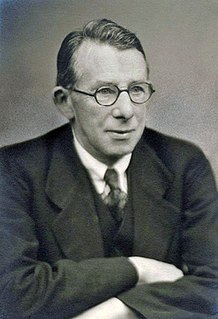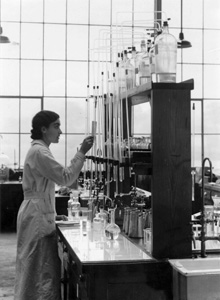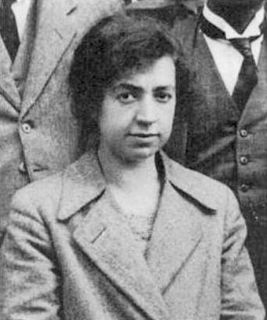Related Research Articles

William Hobson Mills FRS was a British organic chemist.
Dorothy Jordan Lloyd was an early protein scientist who studied the interactions of water with proteins, particularly gelatin. She was also Director of the British Leather Manufacturers' Research Association. She was the first to propose that the structure of globular proteins was maintained by hydrogen bonds, an idea championed later by Linus Pauling and others.

Ida Freund was the first woman to be a university chemistry lecturer in the United Kingdom. She is known for her influence on science teaching, particularly the teaching of women and girls. She wrote two key chemistry textbooks and invented the idea of baking periodic table cupcakes, as well as inventing a gas measuring tube which was named after her.

Grace Coleridge Frankland known as Mrs Percy Franklandnée Grace Toynbee was an English microbiologist. She was one of the nineteen female scientists who wrote the 1904 petition to the Chemical Society to request that they should create some female fellows of the society.

Edith Ellen Humphrey was a British inorganic chemist who carried out pioneering work in co-ordination chemistry at the University of Zurich under Alfred Werner. She is thought to be the first British woman to obtain a doctorate in chemistry.

May Sybil Leslie was an English chemist who worked with Marie Curie and Ernest Rutherford. From 1920 until her death Leslie was a Fellow of the Royal Society of Chemistry.
Millicent Taylor was a British educator and chemist who worked in the fields of organic chemistry and physical chemistry.
Kathleen Culhane Lathbury was a British biochemist known for her work with insulin and vitamins. Lathbury worked as an overseer at British Drug Houses where she was responsible for supervising the manufacture of insulin to make sure it was effective. After her retirement she took up painting and was exhibited in the Royal Academy. She was still driving at the age of 90. She had three sisters, Norah, Rosalind, Christine and two brothers, Robert, and Michael who all had equally remarkable lives
Rose Stern was a teacher from Birmingham, England. She was science mistress at North London Collegiate School for Ladies. While a student at Mason College, she was the first woman student to become a member of the Institute of Chemistry of Great Britain & Ireland. A proponent of grounding chemistry instruction in domestic science, she published A method of teaching chemistry in schools and A short history of chemistry (1924).
Mildred May Gostling, also published under her married name Mildred Mills, was an English chemist who completed research in carbohydrate chemistry. She was one of the nineteen signatories on a letter from professional female chemists to the Chemical Society requesting that women be accepted as Fellows to the Society.
Mary Beatrice Thomas was a lecturer in chemistry at Royal Holloway College and later at Girton College, Cambridge where she was also Director of Studies. She was a noted educator, co-editing a chemistry textbook written by Ida Freund, as well as being one of the nineteen signatories to a petition to the Chemical Society arguing for admission of women as Fellows of the Society.
Katharine Isabella Williams was a British woman chemist who became a student, aged 29, at University College Bristol. She was known for her collaboration in the 1880s with Nobel prize winning Scottish chemist, William Ramsay and was also one of the signatories of the 1904 petition for the admission of women to the Chemical Society.
Dorothy Blanche Louisa Marshall was a British chemist who worked at Girton, Avery Hill and the National Physical Laboratory. In 1904, she signed a petition for women to be admitted as a Fellow of the Chemical Society.
The 1904 petitionto the Chemical Society was a petition written by 19 female chemists setting out the reasons why they should be afforded the status of Fellow of the Chemical Society. The petition is of importance as it eventually led to the admission of women as Fellows of the Society, as well as identifying prominent female chemists working in Britain at this time.
Emily Comber Fortey was a British chemist and politician. She gained her B.Sc. in 1886 before working with Vladimir Markovnikov and Sydney young on fractional distillation. In 1904, she was one of nineteen signatories on a petition to allow the admission of women to the Chemical Society.
Clare de Brereton Evans was a scientist and academic who became the first woman to be awarded a doctorate in Chemistry (DSc). She was a pioneer translator of Meister Eckhart's German works.

Elizabeth Eleanor Field was a British chemist and the Head of Chemistry at Royal Holloway College for over nineteen years. She is also noted as one of the nineteen signatories of the 1904 petition which aimed to grant women the status of Fellows of the Chemical Society.
Katherine Alice Burke was a British chemist and one of the nineteen signatories of the 1904 petition to the Chemical Society.
Alice Emily Smith was a British chemist and one of the nineteen signatories of the 1904 petition to the Chemical Society.
Annie Homer was a biochemist at Newnham College, Cambridge, University of Toronto and the Lister Institute. She developed improved methods for large-scale production of antitoxin sera during World War I.
References
- ↑ "THE RISE AND FALL OF DOMESTIC CHEMISTRY IN HIGHER EDUCATION IN ENGLAND DURING THE EARLY 20TH CENTURY" (PDF). School of Chemical Sciences, University of Illinois. 2011. Retrieved 10 October 2017.
- 1 2 Rayner-Canham, Marelene (2008). Chemistry was their Life: Pioneering British Women Chemists, 1880-1949. Imperial College Press. ISBN 9781860949869.
- ↑ Rayner-Canham, Geoff (2003). "Pounding on the Doors: The Fight for Acceptance of British Women Chemists" (PDF). Bull. Hist. Chem. 28 (2): 110–119.
- ↑ Mason, Joan (1991). "A forty years' war". Chemistry in Britain: 233–238.
- ↑ Creese, Mary R. S. (5 January 2009). "British women of the nineteenth and early twentieth centuries who contributed to research in the chemical sciences". The British Journal for the History of Science. 24 (3): 275–305. doi: 10.1017/S0007087400027370 . PMID 11622943.